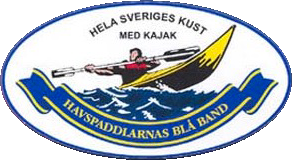Nomad
Latest updated Saturday, January 4, 2025, 16 comments
Images | Particulars | More about
Plans, Nomad - 166 EUR
Purchase
Nomad, designed in1996, is a very fast long distance touring and expedition kayak with record-breaking capability. The origin of the design was a planned attempt on the Swedish Blue Ribbon of sea kayaking, which is an unaided round-the-coast tour – approx 2300 km. The record time at the time of writing is 23 days.
The entire design has been directed towards touring speed: the length, the high initial and secondary stability – no effort is lost to braces or support strokes, every movement of the paddle is translated into distance, and a seakeeping capability that enables a skilled paddler to make shortcuts in conditions that would force most other kayaks inshore.
The hull form is a development of Kavat – but longer, narrower and with slightly finer ends.
Nomad is very roomy to increase the intervals between provisioning stops. It's lightly built to facilitate handling on the water as well as ashore, but strong enough to manage rough landings on rocky shores.
In spite of its length Nomad is easily maneuvered without a rudder (or leaning) but in high winds, all but the strongest and most experienced paddler would want the help of the adjustable skeg, shown in the plans.
In 2012 a Nomad was used for the HBB, with is the entire Swedish Coast from Strömstad to Haparanda during one season, unaided and without interruptions other than night camps:
Jonas Peterson with HBB-number 150, in total 2259 km, in 59 days.
Particulars
| Length¹ |
580/528 cm (overall/WL) |
| Beam |
55/53 cm (overall/WL) |
| Draft |
11 cm |
| Cockpit¹ |
80x40 cm |
| Height¹ |
27.5/22.5 cm (in front of/behind the cockpit) |
| Weight² |
17-22 kg |
| Displacement/volume⁶ |
150 kg/412 litre |
| Speed³ |
7.7/12.4 km/h |
| Prismatic coefficient |
0.58 |
| Wetted surface |
2.19 m² |
| Drag⁴ |
1.68/3.08 kp |
| Stability⁵ |
4/5 (initial/secondary stability) |
| Intended use |
Expedition and touring, coastal and deep sea. Day tours and exercise. |
| Length¹ |
580/528 cm (overall/WL) |
| Beam |
52/50 cm (overall/WL) |
| Draft |
11 cm |
| Cockpit¹ |
80x40 cm |
| Height¹ |
27.5/22.5 cm (in front of/behind the cockpit) |
| Weight² |
17-22 kg |
| Displacement/volume⁶ |
142 kg/390 litre |
| Speed³ |
7.8/12.5 km/h |
| Prismatic coefficient |
0.58 |
| Wetted surface |
2.07 m² |
| Drag⁴ |
1.62/3.02 kp |
| Stability⁵ |
3/4 (initial/secondary stability) |
| Intended use |
Expedition and touring, coastal and deep sea. Day tours and exercise. |
* These dimensions can be adapted to suit personal needs or wishes.
** Depending on type of wood, equipment, care with epoxy usage, sanding etc. etc.
*** The speed numbers are based on mathematical standard formulas (175 lb paddler + 30 lb carco weight) and corrected from the kayaks actual performance om trials, on tours and in races.
⁴ Calculated resistance in 4 and 5 knots (at nominal load capacity).
⁵ Initial stability and secondary stability on a subjective scale, where 1 is very tippy and 5 is very stable.
⁶ Displacement is kayak + paddler + load. Count off the kayak weight to get the load capacity.

Stability
The curve shows the calculated stability with a static load, and therefore of limited use for a real paddler. The part of the curve near zero degrees indicates the initial (primary) stability – the steeper the curve, the more stable. The part of the curve left of the peak indicates end (secondary) stability – the higher and wider, the safer you feel edging the kayak. The position of the peak shows also how much the kayak can be leaned without tipping over. The part of the curve to the right of the peak with rapidly decreasing righting moment is almost impossible to take advantage of.
Plans
The plan sheets contain the information needed to build the kayak/canoe. Station molds, stems and construction details are full scale. For kayaks the recommended cockpit size is shown half scale with offsets for a full scale drawing and advice on altering the size. On the plans you will also find advice on how to shorten or lengthen the craft. Lines and construction drawings are in metric scale 1:10.

 The illustrated step-by-step building manual is in Swedish only, but it is available online in English: it covers all steps in detail and will guide first-time builders through the project.
The illustrated step-by-step building manual is in Swedish only, but it is available online in English: it covers all steps in detail and will guide first-time builders through the project.
Plans, Nomad - 166 EUR
Purchase
Minimum window dimensions to get your kayak out from the workshop:
55x29cm

